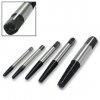josh4tennis
New Member
My 24000 km service has come up, and following a quote from Honda for R5000 I politely declined and decided to get my hand's dirty. A little side note, to put into perspective how much that is, I bought the tools necessary for the job and the replacement parts for R2000 less. However, I'm not looking to slight anyone who makes use of dealership services, in fact I would promote the idea. It was just something I figured I could do to save a little money and grow my tool collection.
Anyway, yesterday, as part of the service, I went ahead and did my valve check/adjustment. It was all fine and well as I'm pretty handy and now have the necessary tools. I removed the radiator, unbuttoned her, and did the check (which I'm glad I did, as cylinder 2 exhaust were tight beyond spec). However, when putting the valve cover back on - disaster. The last of the three bolts used to hold the cover in place broke off inside the engine block. The piece that broke off is seeted inside the block, with nothing sticking out. I am 100% sure, as I took precautions to ensure this, that the bolt was not being cross-threaded, nor being tightened beyond spec. So it came as a shock... But I guess this stuff happens.
I would like to find out if you have any experience and knowledge as to how to remove a broken bolt from an engine block. Unfortunately I don't have any photos of the exact bolt and how it's seeted as I didn't plan to document the procedure, but I will add two photos to show which one it is. Also, would it be possible to ride to a shop with a slightly loose valve cover? I would imagine some, or maybe a lot of oil would leak from the seal.
Any help would be greatly appreciated. Thanks in advance.
On second thoughts - maybe I should have bitten the bullet and just taken it to the dealer


Sent from my SM-N910F using Tapatalk
Anyway, yesterday, as part of the service, I went ahead and did my valve check/adjustment. It was all fine and well as I'm pretty handy and now have the necessary tools. I removed the radiator, unbuttoned her, and did the check (which I'm glad I did, as cylinder 2 exhaust were tight beyond spec). However, when putting the valve cover back on - disaster. The last of the three bolts used to hold the cover in place broke off inside the engine block. The piece that broke off is seeted inside the block, with nothing sticking out. I am 100% sure, as I took precautions to ensure this, that the bolt was not being cross-threaded, nor being tightened beyond spec. So it came as a shock... But I guess this stuff happens.
I would like to find out if you have any experience and knowledge as to how to remove a broken bolt from an engine block. Unfortunately I don't have any photos of the exact bolt and how it's seeted as I didn't plan to document the procedure, but I will add two photos to show which one it is. Also, would it be possible to ride to a shop with a slightly loose valve cover? I would imagine some, or maybe a lot of oil would leak from the seal.
Any help would be greatly appreciated. Thanks in advance.
On second thoughts - maybe I should have bitten the bullet and just taken it to the dealer


Sent from my SM-N910F using Tapatalk






